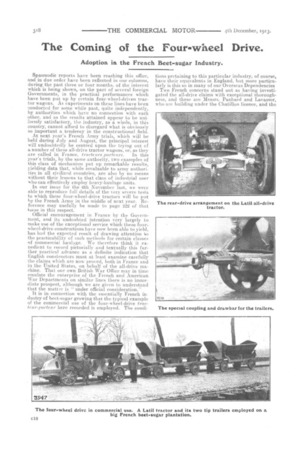The Coming of the Four-wheel Drive.
Page 18

Page 19

If you've noticed an error in this article please click here to report it so we can fix it.
Adoption in the French Beet-sugar Industry.
Spasmodic reports have been reaching this office, and in due order have been reflected in our columns, during the past three or four months, of the interest which is being shown, on the part of several foreign Governments, in the practical performances which have been put up by certain four-wheel-driven tractor wagons. As experiments on these lines have been conducted for some while past, quite independently, by authorities which have no connection with each other, and as the results attained appear to be uniformly satisfactory, the industry, as a whole, in this country, cannot afford to disregard what is obviously so important a tendency in the constructional field.
At next year's French Army trials, which will be held during July and August, the principal interest will undoubtedly be centred upon the trying out of a number of these all-drive tractor wagons, or, as they
are called in France, tracteurs-porteurs. In this year's trials, by the same authority, two examples of this class of mechanism put up remarkable results, yielding data that, while invaluable to army authorities in all civilized countries, are also by no means without their lessons to that class of industrial user who can effectively employ heavy-haulage units.
In our issue for the 6th November last, we were able to reproduce full details of the very severe tests to which these four-wheel-drive tractors will be put by the French Army in the middle of next year. Reference may usefully be made to page 222 of that issue in this respect.
Official encouragement in France by the Government, and its undoubted intention very largely to make use of the exceptional service which these fourwheel-drive constructions have now been able to yield, has had the expected result of drawing attention to the practicability of such methods for certain classes of commercial haulage. We therefore think it expedient to record pictorially and textually this further practical advance as a definite indication that English constructors must at least examine carefully the claims which are now proved, both in France and in the United States, on behalf of the all-drive machine. That. our own British War Office may in time emulate the enterprise of the French and American War Departments on similar lines there is no immediate prospect, although we are given to understand that the matter is " under official consideration."
It is in connection with the essentially French industry of beet-sugar growing that the typical example of the commercial use of the four-wheel-drive trac-teur-porteur here recorded is employed. The condi
tions pertaining to this particular industry, of course, have their equivalents in England, but more particularly is this so in many of our Overseas Dependencies Two French concerns stand out as having investigated the all-drive claims with exceptional thoroughness, and these are Messrs. Panhard and Lavassor, who are building under the Chatillon licence, and the Latil Co., so long famed for its front-drive chassis. It is the latter concern which is responsible for the production of the fine train which we illustrate herewith. This consists of the tractor wagon fitted with a big tipping body, and it hauls after it two big trailers, also fitted with tipping bodies.
Of the tractor chassis itself we have already had much to s.ay in our columns, and of the cleverly-designed and equally well manufactured driving and transmission units we have written on numerous occasions. For all practical purposes, the design of the four-wheel tractor is the same as when we last examined it at the French Show. The final-drive a,r rangement to the back wheels is clearly seen in one of our illustrations, and is typical of the Latil fourwheel method. The details of the drawbar gear, of the spring suspension and of the sturdy tip-locking arrangements are demonstrated in better manner in our illustrations than we can attempt by written word. Twin rubber tires are fitted both on the front and rear wheels of the tractor, but the two trailers are equipped throughout with steel bands. The allmetal bodies are of V section, resting on transverse members built on the chassis longitudinals. They are held in their vertical position by pairs of drawbars and pins at the rear.
























